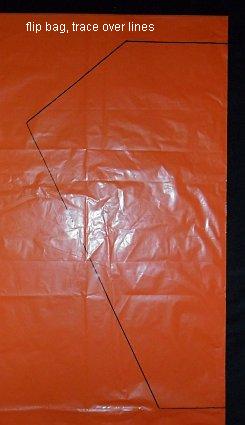- Home Page
- Better Kites
- ... Barn Door Kite
How to Build a Barn Door Kite
Step by Step—Page 1 of 3
The MBK 2-Skewer Barn Door
This set of instructions on how to build a barn door kite assumes you know absolutely nothing about kite making. And if you are a "visual learner", it should be possible to complete the kite by referring only to the pictures.
 MBK 2-Skewer Barn Door
MBK 2-Skewer Barn DoorYou might already have some of the simple tools and materials required. Anything you don't have is easily bought. If it's not exactly what I used, then at least something pretty similar!
Probably the most important thing to get right is making and adjusting the bridle. This trips up so many would-be kite makers who are trying it for the first time! I've tried hard to make the instructions foolproof in this area.
The MBK 2-Skewer Barn Door is medium sized at 58 cm (23 in.) across and 53 cm (21 in.) tall, with generous dihedral and a fairly short looped tail.
The 2-Skewer Barn Door is a very nice light-to-moderate-wind flier. It goes way up into the moderate wind-range in fact—up to around 30 kph if the bridle is adjusted forward enough.
On this site, there's more kite-making info than you can poke a stick at. :-)
Want to know the most convenient way of using it all?
The Big MBK E-book Bundle is a collection of downloads—printable PDF files which provide step-by-step instructions for many kites large and small.
That's every kite in every MBK series.
How to Build a Barn Door Kite
Sail
Now's the time to read up on the tools and materials required for making a skewer kite, if you haven't already.

The template shown above represents one side of the kite sail. The left edge of the template corresponds to the edge of the plastic bag. You will now transfer these measurements to the sail plastic.
Like to see a video clip? Just scroll down to near the end of this page.


- Take a light plastic bag that will fit the entire template shape within one side, and lay it flat on the floor.
- Mark dots on the plastic, corresponding to the corners of the template. There is no need to use a T-square, since any small error will be duplicated on the other side of the sail. And it will make hardly any difference to how the kite flies.
- Using the marking pen, rule lines between the dots to create the template shape.


- Flip the plastic bag over, and trace over all the black lines using your marker pen and ruler.
- Cut out a rectangular section of the bag containing the kite-sail outline.



- Open the bag out, and lay it flat on the floor; you can now see the complete sail outline as in the photo.
- Run clear sticky tape along every straight line, leaving most of the tape on the inside of the sail edges.
- Cut along the black lines with scissors to create the sail. See the closeup photo.
The video shows this latest version of the 2-Skewer Barn Door scooting around in winds of about 20 kph.
As mentioned earlier, there's more kite making on this site than you can poke a stick at. :-)
Want to know the most convenient way of using it all?
The Big MBK E-book Bundle is a collection of downloads—printable PDF files which provide step-by-step instructions for many kites large and small.
That's every kite in every MBK series.
